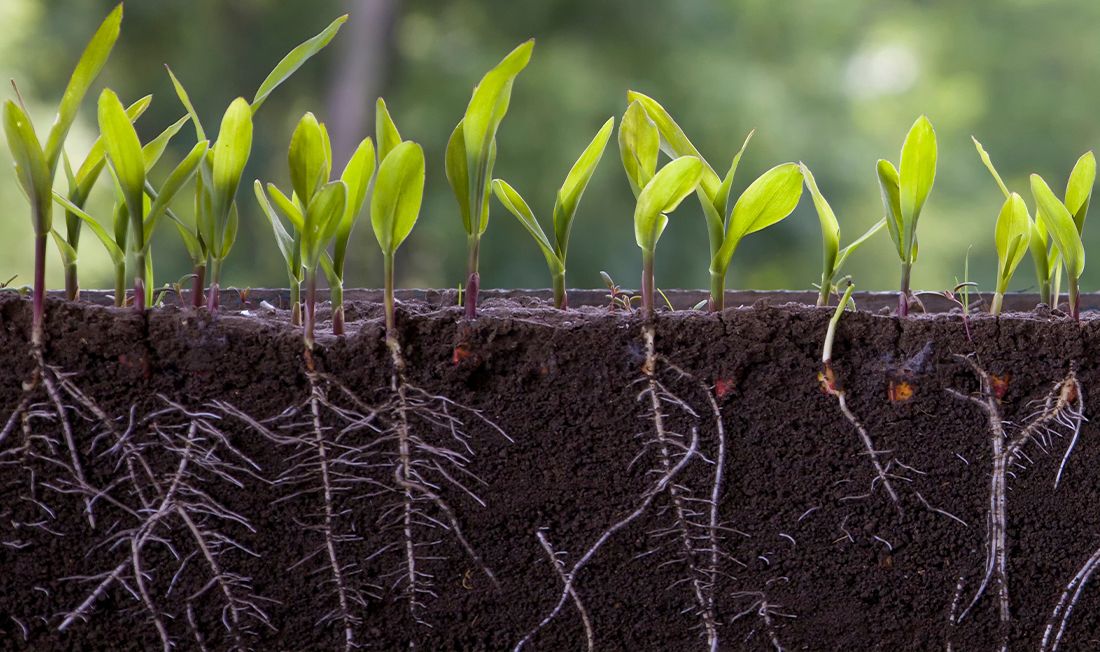Feeding your lawn can be a complex process. There are a plethora of fertilizers, sprayers, spreaders, and equipment, each with different rates and settings. Fortunately, this variety of choices allows us to deliver plant nutrients in the form and quantity that best fits the needs of our lawns. To adapt to changing conditions, plants have developed the ability to absorb their food through a variety of mechanisms. They can absorb nutrients through both their roots and leaves, with each process carrying advantages and disadvantages. Capitalizing on these processes depends on your selection of fertilizers, timing, and application methods.
Nutrient Absorption through Root Uptake
Plants naturally rely on absorbing soil nutrients through their roots to survive. All of the mineral elements required for plant functions can be found in soil, and the roots are the primary method of absorbing them. This uptake occurs via three processes; mass flow, or the continuous flow of nutrients via the soil solution, diffusion of nutrients across the root membrane, and direct interception of nutrients by the roots. Root uptake, being the primary method of nutrient absorption, is advantageous because if sufficient quantities of nutrients are available in the soil in the correct chemical form, then the plant can utilize them as needed. If a plant needs potassium, for example, and potassium is available in the soil, then the plant, in theory, should not exhibit a deficiency.

Limitations of Root Uptake
These root uptake processes can be limited, however, because they depend on factors such as soil water availability, nutrient availability, soil texture, and soil structure. If soil is compacted, then roots and water may not move freely enough throughout the soil to provide sufficient nutrition. Likewise, if soil pH is too high or too low, then nutrients may be bound to soil particles and unavailable for uptake. While soil chemical and structural composition can be changed, these processes can be long and intensive, requiring a variety of applications and sound cultural and mechanical practices.

Nutrient Absorption through Foliar Uptake
Foliar uptake of nutrients is an alternative method of nutrient delivery to root uptake whereby plants can absorb nutrients by diffusion through the leaf membranes. Foliar fertilization is an effective way of delivering nutrients directly to the source, and it enables the applicator to deliver specific nutrients without complete reliance on limiting soil factors. Foliar-applied nutrients are delivered in lower quantities, but exhibit a quicker response than soil-applied nutrients. For this reason, micronutrients are a prime candidate for foliar feeding of not only turfgrass, but fruit and grain crops as well. Macronutrient applications to turfgrasses satiate the desired nutrient needs while the remainder is washed into the soil where it can remain available.

Limitations of Foliar Uptake
Like root uptake, foliar uptake has its limitations. When water is limited, the leaf develops a thicker cuticle, a waxy protective layer, to prevent water loss. The thickened cuticle also decreases the entry of nutrients, meaning that absorption of all foliar-applied products are limited during times of water stress. Since foliar nutrients must be applied in order to be utilized, the process requires more frequent, lower concentration applications. This process, often referred to as “spoon-feeding,” can be limiting for commercial applicators, but is often embraced by homeowners that enjoy working on their lawn.

Deciding What Fertilizer to Use
When deciding which type of fertilizer to use for your next application, there are a multitude of factors to consider. If your lawn is deficient in a certain nutrient or nutrients, then applications of granular fertilizers are likely the best option to bring the concentration of that nutrient into an acceptable range in the soil as they typically contain nutrients in greater quantities. Keep in mind that this can be a long process, so foliar spoon-feeding can supplement necessary nutrients in the meantime. If soil nutrients are balanced, then lower concentration applications of liquid fertilizer can supplement the growing leaf and conserve soil nutrients. Likewise, if factors such as pH and compaction limit soil uptake, then foliar application can keep your turf healthy by limiting reliance on root uptake. Finally, if you’re looking for a quick visual response, the rapid absorption and metabolization provided by liquid foliar feeding will be your best option.









